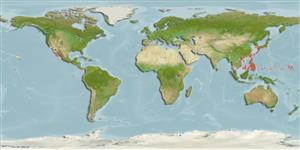>
Gobiiformes (Gobies) >
Gobiidae (Gobies) > Gobionellinae
Etymology: Redigobius: Latin,. Redere = to come back + Latin, gobius = gudgeon.
More on author: Herre.
Environment: milieu / climate zone / depth range / distribution range
Sinh thái học
Biển; Nước ngọt; Thuộc về nước lợ Sống nổi và đáy; sống cả ở nước ngọt và nuớc mặn (Ref. 59012); Mức độ sâu 0 - 5 m (Ref. 86942). Tropical; 21°C - 28°C (Ref. 12468); 35°N - 6°N
Asia and Oceania: Japan southward to the Philippines, Indonesia, New Guinea and Australia. Reported from Africa: south to Coffee Bay, South Africa (Ref. 2798) and Seychelles (Ref. 4343). Widely distributed over the West tropical Pacific, from Japan to the Philippines, Indonesia, New-Guinea, North of Australia, Vanuatu and New Caledonia (Ref. 87781). The Redigobius genus is actually being revised and especially the bikolanus group that should be splitted into several taxa, leading to a revision of the group distribution also (Ref. 87781).
Bộ gần gũi / Khối lượng (Trọng lượng) / Age
Maturity: Lm ? range ? - ? cm
Max length : 4.9 cm TL con đực/không giới tính; (Ref. 11344)
Các tia vây lưng cứng (tổng cộng): 7; Các vây lưng mềm (tổng cộng): 6-8; Tia cứng vây hậu môn 1; Tia mềm vây hậu môn: 6 - 8. Distinguished by the following characteristics: 2-3 dark spot at caudal base (Ref. 2798); Redigobius with dusky scale margins forming network pattern; side of body variably marked with series of dark brown blotches or bars, one blackish, slightly oblique, narrow bar on side of body, second blackish narrow bar present on lower half of body; four distinct dark brown to blackish spots along mid-ventral line at anal fin; second dorsal rays I,6-8; anal rays I,6-8; pectoral rays 14-18; longitudinal scales 21-27; TRB 6 1/2 to 8 1/2; predorsal scales 5-8 (Ref. 84480).
Adults inhabit creeks, rivers and brackish estuaries (Ref. 2847, 44894). Found in tidal streams (Ref. 4343, 44894). Sometimes seen upstream a short distance from the tidal zone. Feed on small fishes and invertebrates. Not seen in markets (Ref. 12693).
Life cycle and mating behavior
Chín muồi sinh dục | Sự tái sinh sản | Đẻ trứng | Các trứng | Sự sinh sản | Ấu trùng
Larson, H.K., 2001. A revision of the gobiid fish genus Mugilogobius (Teleostei: Gobioidei), and its systematic placement. Rec. West. Aust. Mus. (Suppl. No. 62):1-233. (Ref. 43716)
IUCN Red List Status (Ref. 130435)
Threat to humans
Harmless
Human uses
Thêm thông tin
Các tài liệu tham khảoNuôi trồng thủy sảnTổng quan nuôi trồng thủy sảnCác giốngDi truyềnElectrophoresesDi sảnCác bệnhChế biếnNutrientsMass conversion
Các công cụ
Special reports
Download XML
Các nguồn internet
Estimates based on models
Preferred temperature (Ref.
123201): 22.4 - 29, mean 28.4 °C (based on 586 cells).
Phylogenetic diversity index (Ref.
82804): PD
50 = 0.5000 [Uniqueness, from 0.5 = low to 2.0 = high].
Bayesian length-weight: a=0.00977 (0.00442 - 0.02163), b=3.05 (2.86 - 3.24), in cm total length, based on LWR estimates for this (Sub)family-body shape (Ref.
93245).
Mức dinh dưỡng (Ref.
69278): 3.3 ±0.43 se; based on food items.
Thích nghi nhanh (Ref.
120179): Trung bình, thời gian nhân đôi của chủng quần tối thiểu là 1.4 - 4.4 năm (Fec=1,000).
Fishing Vulnerability (Ref.
59153): Low vulnerability (10 of 100).
